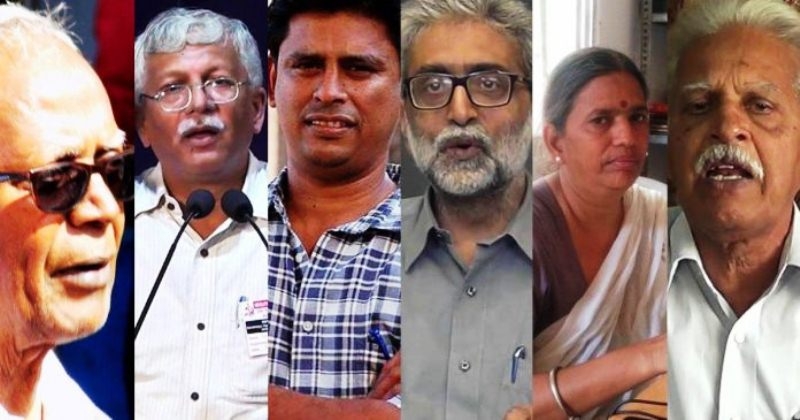Unfolding the tangled knuckles of ‘Urban Naxals’
Unfolding many pages of a secret conspiracy and convicting those responsible for the Bhima Koregaon violence case, the Pune police conducted raids at the residences of five so-called activists across the country for their strong Maoist links. With the arrest of the so-called activists coming into the limelight, the media witnessed a blowing debate in the country between the people who supported and opposed these ‘Urban Naxals’.

Debating over the concept of Urban Naxals, there are many unsaid facts and factors that have been kept hidden in the bouquet will now be clarified from this article.
To understand this concept, let us understand what exactly ‘Urban Naxalism’ is. So, ‘Urban Naxals’ are basically the "Arm Chair Politicians" who are the so-called activists whom we see on television speaking on politics, write about it. These are those who represent themselves as supporters of poor people living in the interiors talking about the injustice encumbered on them through newspapers, television, and social media. They have created an image of being ‘urban Naxals’ before the people.
To understand the demonic face of the Urban Naxals, we need to go in depth to comprehend these people. To begin with, first of all, let us first understand the significance of urban areas in terms of Naxalism. In the year 2001, the Maoists Polit Bureau had published a document called "Urban Perspective". The document illustrates in detail the role played by the Naxalites which helped the police to track down the arrest of the city of Naxalites.
Let us first look at what is known in this document. The statements are given below completely from this document published as ‘Urban Perspective’.
1. Although urban areas are considered to be at the last phase, we still feel the presence of important places in the urban areas. As urban areas are often active, the group will easily get accustomed to active members for conducting movements. The work of the organization in the urban areas is essential for the continuation of the public welfare in rural areas and the Maoist organization to "liberate" the government from exodus. In the urban area, "enemy" is the most powerful. Building a strong organization in urban areas is an integral step to counter this.
2. According to the 2001 census, almost 27% of the population comprising of 28 crores lived in urban areas. In 1951, 56% of the country's income was brought in from the rural area and now the share from this area only amount to 25%. There are a total of 35 centres in the urban division, with a large part of it being in Delhi, Mumbai, Calcutta, and Chennai. These centres are standing for the hard work done by the migrant labourers. The exploited class is not concentrated because these labourers are politically provoked by provincial or religious divisions.
3. The Mao comrade says, "The final objective of the revolution is the capture of the cities, the enemy’s main bases, and this objective cannot be achieved without adequate work in the cities." (Mao, Selected Works, Vol. II, Pg. 317) "Those organizations, which openly propagate Party politics, should generally function secretly. Those organizations functioning openly and legally, generally cannot openly identify with the Party, and should work under some cover with a limited programme." It further states that the organizations which are run legally should undertake limited programs and these organizations should not expose their relationship to the Maoist party. The organizations which are directly working in the party should secretly organize the organization.
4. Correctly coordinating between illegal and legal structures, we should have an approach of step by step raising the forms of struggle and preparing the masses to stand up against the might of the state.
5. The police force, military and other government departments have a strong hold on suppressing the rise of Naxalism in urban areas which suppresses the voice of the revolution. This suppresses the struggle of the workers. Work should be done in the city in such a way that it should be responded to in time.
6. While the main military tasks are performed by the PGA and PLA in the countryside, the urban movement to performs tasks complementary to the rural armed struggle. These involve the sending of cadre to the countryside, infiltration of enemy ranks, organizing in key industries, sabotage actions in coordination with the rural armed struggle, logistical support, etc.
7. The objectives of our intelligence work should be to learn about and study the tactics and plans of the enemy forces in the area, to study the activities of informers, to prevent infiltration into the organization.
8. The document cites, “Infiltration into the Enemy Camp. It is very important to penetrate into the military, para-military forces, police, and higher levels of the administrative machinery of the state. The cities are the strongholds of the enemy and have a large concentration of enemy forces. It is therefore from the cities that attention must be given to this task."
9. Supplies or contacts for supplies of certain types are only available in the urban areas. Examples of such supplies are arms and ammunition, spare parts, certain types of medical supplies, etc. Helping the People’s Army to establish the supply lines in this regard is a task that the urban organization can perform.
10. Logistical networks should be established in absolute secrecy over a period of time. Separate comrades should be allocated for such work and once they are so allocated they should be released from other work and delinked completely from the mass work.
11. The urban cadres of the Naxal groups are given the responsibility of fighting the cyber war with the military.
As we entangled the clutches of the tangled concept of Urban Naxals, a part of the document also focuses on the ‘Hindu Fascists’ group and what can be done against them in the city